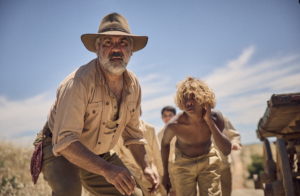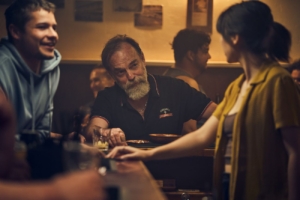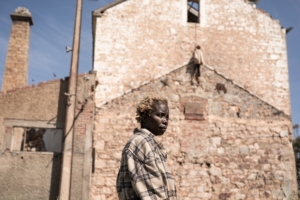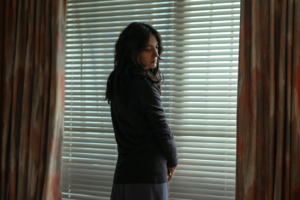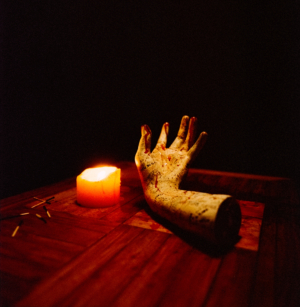With the release of Matthew Holmes’ The Legend of Ben Hall (2016), I’m led to wonder: just what is the enduring appeal of bushranger films in Australia? What does it say about a country that makes a legendary (possibly even ‘iconic’, if that weren’t so wildly overused a word) figure of Ned Kelly? Is there some suggestion of these figures acquiring glamour because of their iconoclastic attitudes to authority, an authority still very much that of a colony under imperial rule? Whatever the answers to such questions, the fact is that the bushranger subgenre was so popular in the early years of the twentieth century that action was taken to stall its continuance.
In 1911–1912, the governments of New South Wales, South Australia and Victoria placed bans on the further production and screening of films relating to the exploits of bushrangers,[1]‘Australian Film and Television Chronology’, australianscreen, <http://aso.gov.au/chronology/1910s/>, accessed 8 May 2017. and the epochal The Story of the Kelly Gang (Charles Tait, 1906) – the longest narrative film in the world at that time – and works like it were banned in several states until the 1940s.[2]See Luke Buckmaster, ‘The Story of the Kelly Gang Rewatched – the World’s First Feature-length Film’, The Guardian, 6 March 2016, <https://www.theguardian.com/film/2016/mar/06/the-story-of-the-kelly-gang-rewatched-the-worlds-first-feature-length-film>, accessed 8 May 2017. Since the lifting of the ban, there have been a dozen or more large- and small-screen versions of Kelly’s adventures, as well as two adaptations of Rolf Boldrewood’s novel Robbery Under Arms (Jack Lee, 1957; Donald Crombie & Ken Hannam, 1985).[3]Prior to the ban, there were three adaptations of the novel (Charles MacMahon, 1907; John Tait et al., 1907; Alfred Rolfe, 1911). During the ban, just one bushranger film made it past the censors: a fourth adaptation, directed by Kenneth Brampton, released in 1920. In more recent decades, the subgenre has attracted the attention of big-name stars such as Peter Finch and Sam Neill, who incarnated Boldrewood’s Captain Starlight in 1957 and 1985, respectively, and Mick Jagger and Heath Ledger, who played Kelly in the 1970 (Tony Richardson) and 2003 (Gregor Jordan) versions of the Kelly saga.[4]See Brian McFarlane, ‘Ned Kelly Rides Again … and Again and Again’, Screen Education, no. 41, Summer 2006, pp. 24–32. Not to forget Mad Dog Morgan (Philippe Mora, 1976), which enticed zeitgeist antihero Dennis Hopper to Australia.[5]See Jake Wilson’s excellent account of this in his Mad Dog Morgan, Currency Press, Sydney, 2015.
The idea of bushrangers as heroes has most often led to their being depicted as romantic adventurers. But aren’t they also, in the carrying out of their intentions, dangerous predators? Or both perhaps? Those big names referred to above meant that filmgoers at the time weren’t being invited merely to dismiss them as criminals. A major strength of this new film is that it doesn’t romanticise one of the most famous of them all. Writer/director Holmes, whose second feature this is, has chosen to open his film with the bold assertion, ‘This is a true story’ – though after the final credits there is a caption suggesting that there has been some fictional input. Perhaps ‘This is based on some real-life events’ might, then, have been a more accurate opening statement, since life is apt to be a less structured affair than what we think of as a ‘story’.
The air of intended veracity is further announced with titles such as that naming Ben Hall (played by co-producer Jack Martin) as ‘the most hunted man’ in the Empire, and by the use of sepia portraits that are so redolent of the period when photography was in its infant stages. The final one of these gradually dissolves into a live shot of Ben, standing with his back to the camera as he surveys the vast landscape that has been the scene of his maraudings.
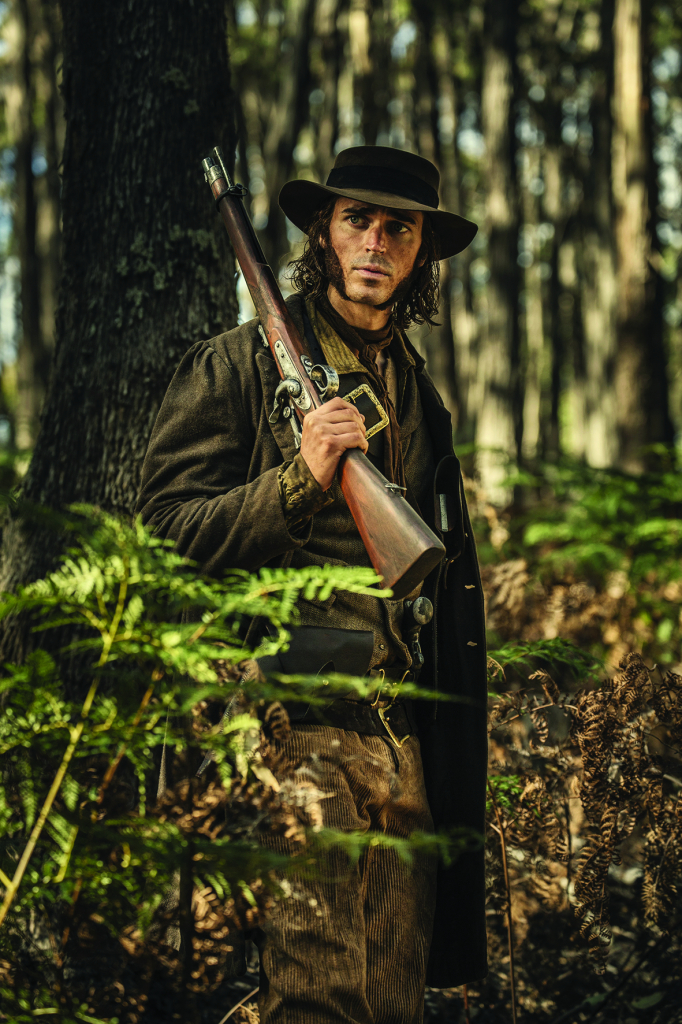
Having said that, I should add that what might have been a straggling series of exploits gets strength and holding power from the ways in which Holmes has imbued his protagonist with a real sense of complexity. Martin’s Ben combines both the violent impulses that account for his outlaw sprees and the insights that reveal a real tenderness, as he reflects on those aspects of his personal life that continue to cause him pain. And the film’s narrative and imagistic aesthetic reinforce this complexity as it moves so fluently between sweeping vistas of the Australian outback and detailed close-ups that remind us that there is more to this often-terrifying figure than his readiness with a gun.
These elements are apparent in the film’s opening sequence, a shootout – sharply edited by Caitlin Spiller – that anticipates the stylistic contrasts that follow. Ben and his ancient and dozy companion, Old Man Gordon (Andy McPhee), are riding through a silvery gumtree forest, where they stop for a spell. The old man goes to sleep during his ‘watch’ when police approach with rifles at the ready and shouting at Ben to surrender, and there is an exchange of shots in which bushranger and offsider are injured. In this brief episode, the always-present threat of violence hovers over the beauty of the outback and the intimacy of Ben’s reflecting on a cameo of a woman, who we learn shortly is his wife, Biddy (Joanne Dobbin). After this episode, Holmes cuts to a close-up of bacon and eggs being cooked in a log cabin and thence to Ben’s tucking in.
In the many episodes that follow, titles are given as to place and date, and this is no doubt another gesture in the interests of rendering the ‘true story’ foreshadowed at the film’s start. There is no need to describe these exploits or sprees in detail, whether they involve holding up a mail coach from which passengers are forced to disembark, or attacking the gold escort, or the ball in an outback town where Ben and his companions in crime at first throw themselves into the festivities but then indulge in wildly destructive arson. It is enough to say that these are uniformly well shot, directed and edited with a skill that keeps them absorbing despite the risk of repetition. Holmes certainly has a flair for the action sequence, but happily eschews the mindless display of CGI pandemonium that is currently so endemic in big-budget cinema. I’ve read that The Legend of Ben Hall was a low-budget production,[6]Odin’s Eye, The Legend of Ben Hall press kit, 2016, p. 9. but the final result doesn’t look like this and certainly doesn’t suffer in light of its financially straitened circumstances.
As with the film’s view of Ben, these action sequences are in no way romanticised, nor are they burdened with credibility-straining extravagance. The action is as vicious and frightening as it must have been for its real-life progenitors – with, for instance, parents being properly afraid for their children – but it never ends by looking like mindless mayhem. The film conjures a convincing aura about what makes Ben and his gang so ‘wanted’ by the authorities, about why such then-huge sums are being offered for their capture. They seriously threaten the safety and livelihoods of those whose territories they invade, to the point where a newspaper reports that an act has been passed exculpating anyone who kills Ben or either of his offsiders.
There is a silence about Martin’s rendering of Ben, which the film seeks to explain through the way it punctuates the expected action with a sense of the personal and of the past that is always there behind the face shown to the world.
When Gordon decides he’s had enough of their exciting life of riding the range together, and after a painful family encounter, Ben takes on two new comrades-in-arms, as it were. At Billabong Creek, 1864, he meets up with an old accomplice, ‘Happy Jack’ Gilbert (Jamie Coffa), whose manic behaviour makes him a dangerous associate, and who urges Ben to get back into the game when Ben says it’s time to skip the country – preferably to the US, where there is only a civil war to contend with. Gilbert brings another to the gang in the person of eighteen-year-old John Dunn (William Lee), and the trio head off on their plundering spree.
Holmes takes care to distinguish the three men sufficiently to ensure there is some element of character differentiation – and sometimes conflict – as well. The laughaholic Jack can be counted on to act like a hand grenade in most situations, such as when he brings a cheerful log-hut ballroom to silence by firing his pistol – at the roof, certainly, though he will later fire it so as to kill and thereby increase the price offered on the gang’s heads. John, on the other hand, is aware of his junior position in the trio, addressing Ben as ‘Mr Hall’ and asking thoughtfully, ‘Why did you become a bushranger?’ In a small but telling detail, John is presented as more mannerly and more literate than the crazy, self-obsessed Jack. And, as the film progresses, he becomes more assured, and some sense of schism develops between the three – or four, after they add another to the band, in the person of Daniel Ryan (Callan Macauliffe).
It is this kind of care for establishing the characters not merely as a gang but as individuals that contributes to the variety of responses called up by the film’s narrative. These roles are written with enough detail to distinguish the men from one another, but the film is equally fortunate in the casting and acting of the roles. In particular, Martin bears a striking physical resemblance to the sepia portrait of the real Hall, and Holmes is clearly as interested in what makes these men tick in their different ways as in their criminal activities.

In answer to John’s question about why Ben took to bushranging, another key aspect of the film is foregrounded. He tells John the sad tale of how Biddy had gone off with another man, Jim Taylor (Nick Barry), taking Ben’s and her son, Henry (Zane Ciarma), with her. ‘You don’t know true hatred till someone destroys your family,’ Ben says, affecting real pain. We have seen Ben earlier in the film during a tense exchange with Biddy, who tells him, ‘You’re not welcome here.’ He wants Henry to acknowledge him as ‘Daddy’, but he’s asking a lot of this sad-faced little boy.
My point is that the film takes this aspect of Ben’s history seriously, as if in helping to account for the dangerous career he has embarked on. He is haunted by images of wife and child as he hurtles about the countryside, at one point making off with Henry so that the child can be brought up by Ben’s brother and sister-in-law. There is a silence about Martin’s rendering of Ben, which the film seeks to explain (though that word is too didactic in implication) through the way it punctuates the expected action with a sense of the personal and of the past that is always there behind the face shown to the world.
It’s a long time since I saw the 1985 version of Robbery Under Arms, but I was struck by this comment about how its protagonist emerged: ‘If one were to offer criticism of Starlight, it is that his motives for becoming a bushranger are barely touched […] too much is assumed rather than explained about this film’s romantic hero.’[7]Greg Kerr, ‘Robbery Under Arms’, in Scott Murray (ed.), Australian Film: 1978–1994, Oxford University Press, Melbourne, 1995, p. 175. Such a charge could not be levelled at Holmes’ rendition of the Ben Hall legend, and a local review of the new film seems, to me, to miss the point of this performance when it claims Martin ‘fails to generate much heat in the role. He’s too polite.’[8]Sandra Hall, ‘The Legend of Ben Hall Review: The Final Nine Months of an Overlooked Bushranger’, The Age, 27 November 2016, <http://www.theage.com.au/entertainment/movies/the-legend-of-ben-hall-review-the-final-nine-months-of-an-overlooked-bushranger-20161121-gsubao.html>, accessed 8 May 2017. The film benefits from the contrast between him, Coffa’s boisterous Jack and Lee’s naively open John. The Ben that emerges is not just a ruthless criminal, but a man seriously at odds with himself and society. This is a man who claims he would never shoot someone who hadn’t had a go at him first.

How does the film represent the Australia that Hall’s gang terrorises? It is magnificently photographed, with vistas of often-alarming countryside, harsh and unyielding, on the one hand, and others of peaceful mountain terrain that accentuate the gang’s maraudings. The settlements where the gang fetches up are created with an air of believability that is a tribute to Das Patterson’s production design – and the filmmakers’ capacity to make a little go a long way.
Holmes had made an unreleased short film, The Last Days of Ben Hall (2014), probably as part of his research for the current feature. His preparations have been rewarded by a film that is gripping enough as a conventional adventure, but also has a good deal more to offer. In the end, one is left to ponder what kind of country, what kind of culture, heroicises the likes of Starlight, the Kelly gang or Ben Hall.
http://www.thelegendofbenhall.com
Endnotes
| 1 | ‘Australian Film and Television Chronology’, australianscreen, <http://aso.gov.au/chronology/1910s/>, accessed 8 May 2017. |
|---|---|
| 2 | See Luke Buckmaster, ‘The Story of the Kelly Gang Rewatched – the World’s First Feature-length Film’, The Guardian, 6 March 2016, <https://www.theguardian.com/film/2016/mar/06/the-story-of-the-kelly-gang-rewatched-the-worlds-first-feature-length-film>, accessed 8 May 2017. |
| 3 | Prior to the ban, there were three adaptations of the novel (Charles MacMahon, 1907; John Tait et al., 1907; Alfred Rolfe, 1911). During the ban, just one bushranger film made it past the censors: a fourth adaptation, directed by Kenneth Brampton, released in 1920. |
| 4 | See Brian McFarlane, ‘Ned Kelly Rides Again … and Again and Again’, Screen Education, no. 41, Summer 2006, pp. 24–32. |
| 5 | See Jake Wilson’s excellent account of this in his Mad Dog Morgan, Currency Press, Sydney, 2015. |
| 6 | Odin’s Eye, The Legend of Ben Hall press kit, 2016, p. 9. |
| 7 | Greg Kerr, ‘Robbery Under Arms’, in Scott Murray (ed.), Australian Film: 1978–1994, Oxford University Press, Melbourne, 1995, p. 175. |
| 8 | Sandra Hall, ‘The Legend of Ben Hall Review: The Final Nine Months of an Overlooked Bushranger’, The Age, 27 November 2016, <http://www.theage.com.au/entertainment/movies/the-legend-of-ben-hall-review-the-final-nine-months-of-an-overlooked-bushranger-20161121-gsubao.html>, accessed 8 May 2017. |

